LinkedIn is a powerful social media site and one that your business shouldn’t ignore. But to achieve the results you’re looking for, you need to implement an effective B2B LinkedIn marketing strategy.
What is a LinkedIn B2B marketing strategy, and how do you implement one? We’ve covered everything you need to know about marketing your business on LinkedIn in our guide below.
B2B LinkedIn Marketing by the Numbers
Before we dive into which LinkedIn B2B strategies to try, we need to explain why having a LinkedIn B2B marketing strategy is so essential and what makes LinkedIn such a powerful B2B marketing channel.
First off, LinkedIn has over 822 million members across 200 countries and generated $11.5 billion in revenue in 2021. However, who those users are is what makes LinkedIn such an effective B2B marketing tool. Over 65 million business decision-makers are using its platform. That means many of the people your brand may be trying to reach — such as executives and key decision-makers — are active on LinkedIn. In 2020, 62% of Fortune 500 CEOs utilized social media. Out of those CEOs, 94% were on LinkedIn. So with the right B2B marketing strategy, your brand can leverage LinkedIn to open the door to new business opportunities.
In addition to reaching the right audience, LinkedIn helps marketers build trust in their brand. The platform reports that 55% of the decision-makers on LinkedIn use thought leadership content to vet other organizations. Therefore, by implementing a B2B content marketing strategy on LinkedIn, your brand can enhance its reputation, foster trust and improve its credibility among key decision-makers.
The takeaway: There are a lot of people using LinkedIn around the world — many of whom can help you grow your business. By creating and executing an effective B2B marketing strategy for your target audience on LinkedIn, you can:
- Help users find solutions to their business problems.
- Initiate conversations that lead to better brand recognition and loyalty.
- Subtly guide key business leaders and decision-makers to your brand.
7 B2B Strategies to Try on LinkedIn
LinkedIn is a gold mine for B2B marketing, with countless opportunities to grow your brand using the social media site. However, to get the results you’re striving to achieve, you need to implement an effective B2B marketing strategy. Lucky for you, we’ve listed 7 of our favorite LinkedIn B2B marketing strategies for you to try. Let’s explore.
1. Direct Users With a Showcase Page
A Showcase Page on LinkedIn allows you to spotlight the specific brands or products that are a part of your company. Not only does this help a parent company organize and display the various brands that fall under their umbrella, but it also makes it easy for users to navigate to a specific LinkedIn page quickly.
Adobe does a great job at using the showcase functionality. The brand created affiliate pages for its core products, including Creative Cloud, Marketing Cloud and Digital Publishing Suite. The company recognized that the people using Marketing Cloud might be different from those using its Digital Publishing Suite. Leveraging the LinkedIn Showcase feature, Adobe created niches for its different products so they can personalize the content for each of their unique audiences.
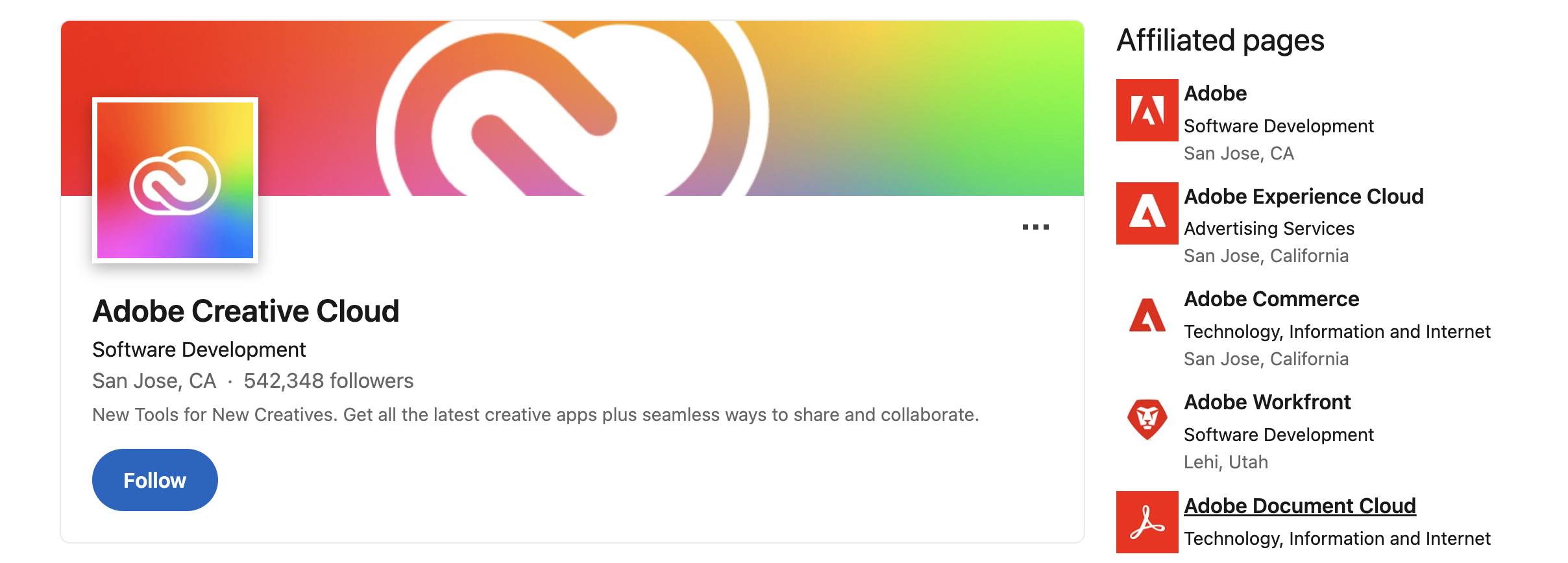
When it comes to creating a well-developed showcase page, there are a few best practices to keep in mind:
- Use clear names: Name your showcase pages after the product or brand it’s promoting.
- Provide as much detail as possible: Fill out all of the information fields on the showcase page to make the page more professional, polished and helpful for users.
- Don’t go overboard: While you can create as many as 10 showcase pages at a time, that doesn’t mean you should. Instead, focus on creating pages for products or brands that have an audience big enough to support them.
And if you’re curious about how to create a LinkedIn Showcase Page, this video should help:
2. Create Advanced Searches
LinkedIn provides the perfect opportunity for marketers and business leaders to connect with other professionals. While having an extensive network or following can be great for your business, you want to ensure you’re connecting with users who qualify as business leads. To do this, we recommend utilizing LinkedIn’s advanced search option. Doing so allows you to target specific types of people — ideally, people who are likely to do business with your brand.
Start by entering general search terms in the search bar at the top of the page.

Then click the magnifying glass to the right. Once you do, you’ll see LinkedIn’s advanced filters appear below the search bar, allowing you to specify who you’re searching for.

Once here, you can search for people, jobs, types of content and more. You can also apply filters to search for people based on your connections, specific regions or companies they work for.
So, what should you do once you’ve found a few new prospects? Connect with them, of course! Growing your professional network can help you bolster brand awareness and form relationships with people who may become customers. A study from HubSpot found that LinkedIn’s visitor-to-lead conversion rate was 2.74% — nearly 3 times higher than Twitter and Facebook. So be sure to leverage LinkedIn’s advanced search features to find new leads, connect with them, and — eventually — convert them into customers.
Subscribe to
The Content Marketer
Get weekly insights, advice and opinions about all things digital marketing.
Thank you for subscribing to The Content Marketer!
3. …Then Save Those Searches
After putting all that effort into creating a detailed search for potential leads on LinkedIn, don’t let your hard work go to waste. Save your advanced searches so you can use them to find more B2B leads in the future.
To do this, you’ll see a “Save Search” button in the top right corner of your page. Click it, create a name and voilà! You can easily pull up that search again to find more professionals to connect with.

Just bear in mind that if you don’t upgrade your LinkedIn account, you’ll only be able to save 3 searches at a time. Some softwares like LinkedHelper allows smart search features along with automated scraping and downloading entire datasets in a spreadsheet.
4. Run Targeted LinkedIn Ads
Similar to Facebook and Instagram, you can create and deploy ads through LinkedIn. The social media platform has over 20 unique audience attributes, allowing you to create targeted ads for the right B2B audience. For example, you can create an audience based on a company’s name or size, empowering you to market to specific types of businesses and the leaders in charge of them.
This video from LinkedIn provides a quick demo of how to set up a target audience for your B2B ad campaign:
Once you have a clearly defined audience, you can create compelling content for your ads. A few best practices for creating ads that grab attention and convert users to leads include:
- Incorporate words that resonate with your target audience and speak to their pain points or interests.
- Encourage users to take action by offering a free trial or white paper download.
- Include imagery that will capture your audience’s attention while still being relevant to what you’re offering.
As a bonus, LinkedIn gives you the ability to test multiple ad variations — otherwise known as A/B testing. That means you can create anywhere from 2 to 4 different variations of your ad and test which one performs the best. You can rotate the ads evenly or optimize the ads for performance. If optimizing for performance, the ad that receives the highest number of impressions will be shown more often than the others.
5. Publish High-Quality, Consistent Content
Another great way to connect with potential new clients on LinkedIn is through high-quality content. You have the option to post videos, infographics, blogs and third-party content on your page to boost your digital presence, increase your following and improve brand awareness.
With that in mind, it’s important to note that creating one post on LinkedIn won’t immediately generate results. To make the most out of your LinkedIn content, you need to develop and implement an effective, long-term content strategy.
For starters, create posts that speak to your target audience. By understanding their pain points, interests and the problems they’re seeking to solve, you can develop content that your target users find helpful and interesting. Not only can this inspire them to engage with your brand on LinkedIn, but it may also motivate them to share your content, thus resulting in your post reaching even more potential customers.
When it comes to determining what to include in your LinkedIn content, it’s best to maintain an authentic voice. Try to avoid posting promotional and salesy content on your page — this typically doesn’t render the best engagement. Instead, produce content that piques your target audience’s interest and sparks conversation. According to EveryoneSocial, Dell’s former CEO Amy Heiss noted that only 20% of Dell’s social media topics are actually about Dell — the other 80% of the company’s posts are informative, helpful, relevant or personally interesting to its employees and customers.
A great example of a company leveraging LinkedIn to spark discussions is Microsoft. The brand frequently posts questions or general tips that their target audience — office workers — should find interesting. As you can see in the screenshots below, these posts may not be directly promoting Microsoft products, but they resulted in plenty of shares, reactions and comments.
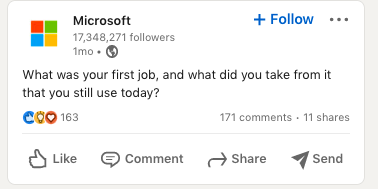
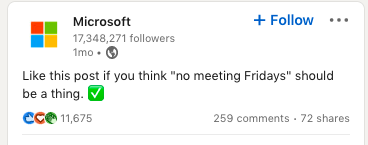
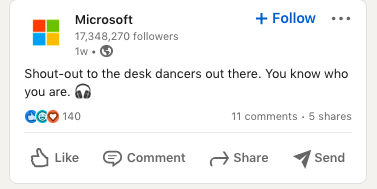
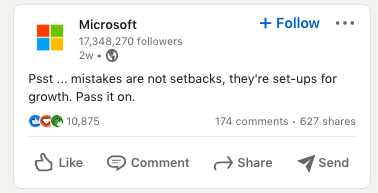
In addition to creating purposeful, high-quality content for your target audience, a few other best practices to help you get the most out of your LinkedIn content strategy include:
- Incorporating images into your posts: Hootsuite reports LinkedIn posts with images receive twice as much engagement.
- Including hashtags: LinkedIn hashtags help you to categorize content and reach users with shared interests.
- Maintaining consistency: Create a publishing schedule and stick to it to help build trust in your audience and establish yourself as a consistent source of high-quality content.
6. Encourage Your Employees to Advocate for Your Brand on LinkedIn
According to LinkedIn, your average employee has a network that’s 10 times larger than your brand’s following. With that in mind, an excellent B2B marketing strategy for LinkedIn is to encourage your team to help grow your brand on the social media platform. By engaging with your business content — such as commenting, sharing or reacting to your company’s posts — your employees can help boost your reach and drive awareness.
Getting your employees involved in your LinkedIn marketing strategy can demonstrate employee advocacy. Employee advocacy is essential because when employees promote the company they work for, the message can produce a more powerful impact than when it comes from the business itself. Sociabble reports that leads from employee advocacy convert 7 times more frequently than leads from other sources.
So, how can you get your employees to advocate for your brand on LinkedIn? It can help to designate a few employees to lead the charge. These could be senior leaders, long-time employees, members of your sales team or employees who are already active on LinkedIn. And if these team members frequently engage with your company posts on LinkedIn, others may join in.
It can also help to build an incentive or recognition program, so more of your team is motivated to engage with the brand on LinkedIn. You can run contests, such as rewarding employees who interact the most with a gift card or an extra PTO day. Essentially, you want to create a work environment where your team actively advocates for the brand on LinkedIn, so you can continue driving your marketing strategy forward.
7. Direct LinkedIn Users to Your Website
Think of your company’s LinkedIn page as an express lane to your website. When designing the profile, include clear, actionable links to your website to drive traffic there. When you create posts, include website links whenever possible. LinkedIn even gives companies the option to add call-to-action (CTA) buttons to their pages, which you can leverage to send more people to your website.
Once you get your target audience to your website, you can:
- Serve them more engaging, informative or relatable content to continue building trust in your brand.
- Direct them to a landing page that will inspire them to take action, such as completing a contact form.
- Continue to engage with them through retargeted ads once they’ve left your website.
The bottom line: Utilize LinkedIn to send more people to your website. If you’re unsure of how to use LinkedIn’s CTA feature, this video provides a great tutorial:
Putting Your LinkedIn Strategy Into Action
So far in this article, we’ve covered why having a B2B marketing strategy on LinkedIn is essential and which ones you might want to try. Now, it’s time to cover how to create a LinkedIn marketing strategy that works for your business.
The first step is to identify your target audience and keep them at the center of your LinkedIn marketing efforts. That means if you’re generating content, keep your target audience in mind every step of the way. For example, create a blog that speaks directly to their interests. If you’re running targeted ad campaigns, use buzzwords that grab their attention or show how you can solve a problem they’re encountering. Know your target audience, then create a B2B marketing strategy that speaks to them.
Next, make sure your LinkedIn company page is set up for success. LinkedIn reports that profiles with complete information receive 30% more weekly views than incomplete ones. So before you dive too deep into your new marketing strategy, give your company page a quick audit. Be sure the page includes:
- Your company logo: Having your logo on your LinkedIn page helps establish credibility.
- A company overview: Incorporate a brief overview of what the company is, its mission and values, and the solutions it can provide.
- Organization info: Make sure the profile includes a clear link to your company website and other contact key details like its location, size and the industry it caters to.
Bonus tip: While auditing your LinkedIn profile, you can easily add a LinkedIn showcase page, which is one of our recommended LinkedIn B2B marketing strategies.
One more thing to do before kickstarting your marketing strategy is to review your current LinkedIn stats. Make note of key metrics, such as how many leads, profile visits, and website clicks you’re currently receiving from LinkedIn. These numbers will form a benchmark that you can measure against once your strategy gets underway. Ideally, these metrics will increase, and you’ll be able to see how effective your new B2B marketing strategy is.
The bottom line is that there are many different ways you can leverage LinkedIn to grow your business and drive key marketing results. If you’re looking for more insights into new LinkedIn features to try — or the latest developments in digital marketing — stay informed by signing up for our newsletter.





